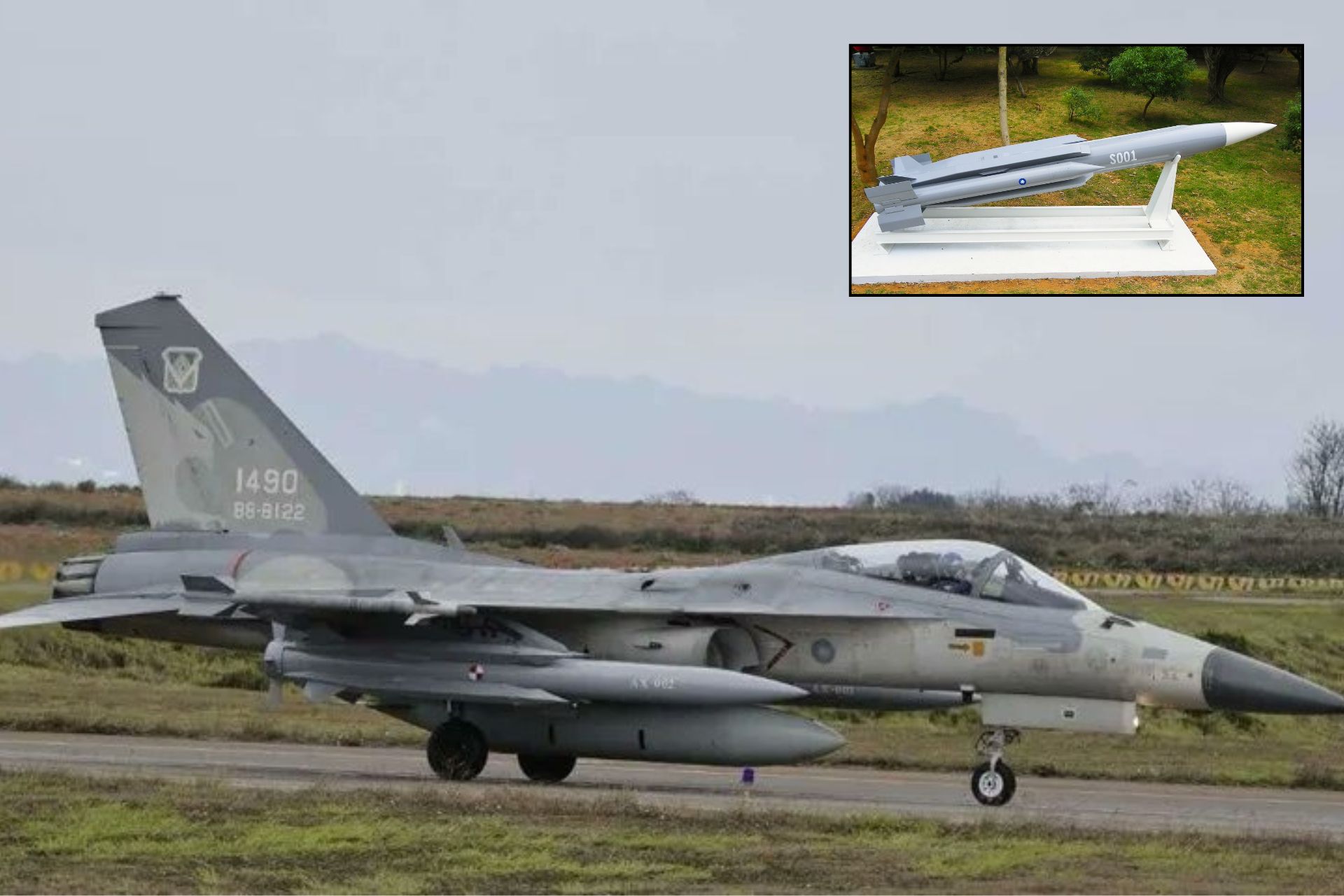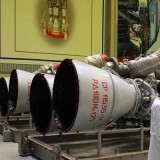Taiwan Arms F-CK-1 Fighters with Supersonic HF-3 Missile to Counter Growing Chinese Naval Threat

{loadposition bannertop}
{loadposition sidebarpub}
On February 21, 2025, the Taiwanese newspaper United Daily News (UDN) published what appears to be the first clear image of an air-launched HF-3 missile mounted on a Taiwan Air Force (ROCAF) F-CK-1 fighter. A few days later, the Liberty Times also released another image of the missile under the aircraft’s wing, confirming progress in the program. These publications, widely shared on social media, indicate a new step in integrating the supersonic missile onto a combat aircraft, potentially altering Taiwan’s maritime strike capabilities.
Follow Army Recognition on Google News at this link
An air-launched HF-3 missile mounted on a Taiwan Air Force (ROCAF) F-CK-1 fighter (Picture source: UND)
The images show a single HF-3 missile mounted under one wing of the aircraft, with inscriptions and positioning markings suggesting its use in testing and evaluations. Observers noted the presence of a rotating sleeve at the missile’s end, which may assist in stabilization after release. Additional photos depict an F-CK-1 undergoing ground tests with two HF-3 missiles, an external fuel tank, and two Sky Sword air-to-air missiles for self-defense, indicating a possible future operational configuration.
Although the project to equip F-CK-1 fighters with the HF-3 was first proposed in 2017, it faced multiple challenges, mainly due to the original missile’s size and weight, which measured 6.1 meters in length, 46 centimeters in diameter, and weighed approximately 1,500 kg. Adapting it for an aerial platform required significant reductions in both weight and dimensions, a task undertaken by the National Chung-Shan Institute of Science and Technology (NCSIST) in 2022.
NCSIST engineers gradually scaled down the HF-3, resulting in a modified version measuring 5.5 meters in length, 36 centimeters in diameter, and weighing under 900 kg. One key modification was the removal of the solid-fuel boosters, previously used for launches from land and naval platforms, which reduced the missile’s weight by around 200 kg.
The program experienced delays but resumed in September 2024 with renewed testing over maritime and flight environments. According to recent reports, operational tests are expected to begin in 2025, including separation tests and potentially a first live-fire test from an F-CK-1.
The HF-3 sometimes referred to as a “carrier killer,” is powered by a liquid-fuel ramjet engine, enabling it to reach speeds of Mach 3.5 with a range of up to 400 km. Compared to the AGM-84 Harpoon currently used by Taiwan’s air force, the HF-3 offers extended range and higher speed, making it more difficult to intercept. Its guidance system combines inertial navigation with active radar homing for terminal targeting. The missile’s warhead, weighing 225 kg in land- and sea-based versions, is designed to maximize damage by directing the explosion toward a ship’s hull.
Developed by NCSIST since the 1990s, the HF-3 was first tested in 1997 and integrated into Taiwan’s navy in 2007 aboard Kang Ding- and Cheng Kung-class frigates. It is also deployed on Tuo Chiang-class corvettes alongside other missile systems. Adapting it for aerial deployment represents a significant shift, allowing for a more mobile and unpredictable strike capability.
By integrating the HF-3 into its F-CK-1 fighters, Taiwan expands its options for anti-ship operations and enhances its deterrence capabilities against the Chinese navy. Some analysts have suggested that if successful, this development could also extend the operational life of the F-CK-1 or even lead to the design of a new indigenous combat aircraft.
As tensions in the Taiwan Strait continue to escalate, deploying an air-launched supersonic missile such as the HF-3 could become a key element in Taiwan’s defense strategy. If the program proceeds as planned, the ROCAF will soon have an additional capability to challenge China’s naval presence and complicate any potential blockade or invasion scenario.

{loadposition bannertop}
{loadposition sidebarpub}
On February 21, 2025, the Taiwanese newspaper United Daily News (UDN) published what appears to be the first clear image of an air-launched HF-3 missile mounted on a Taiwan Air Force (ROCAF) F-CK-1 fighter. A few days later, the Liberty Times also released another image of the missile under the aircraft’s wing, confirming progress in the program. These publications, widely shared on social media, indicate a new step in integrating the supersonic missile onto a combat aircraft, potentially altering Taiwan’s maritime strike capabilities.
An air-launched HF-3 missile mounted on a Taiwan Air Force (ROCAF) F-CK-1 fighter (Picture source: UND)
The images show a single HF-3 missile mounted under one wing of the aircraft, with inscriptions and positioning markings suggesting its use in testing and evaluations. Observers noted the presence of a rotating sleeve at the missile’s end, which may assist in stabilization after release. Additional photos depict an F-CK-1 undergoing ground tests with two HF-3 missiles, an external fuel tank, and two Sky Sword air-to-air missiles for self-defense, indicating a possible future operational configuration.
Although the project to equip F-CK-1 fighters with the HF-3 was first proposed in 2017, it faced multiple challenges, mainly due to the original missile’s size and weight, which measured 6.1 meters in length, 46 centimeters in diameter, and weighed approximately 1,500 kg. Adapting it for an aerial platform required significant reductions in both weight and dimensions, a task undertaken by the National Chung-Shan Institute of Science and Technology (NCSIST) in 2022.
NCSIST engineers gradually scaled down the HF-3, resulting in a modified version measuring 5.5 meters in length, 36 centimeters in diameter, and weighing under 900 kg. One key modification was the removal of the solid-fuel boosters, previously used for launches from land and naval platforms, which reduced the missile’s weight by around 200 kg.
The program experienced delays but resumed in September 2024 with renewed testing over maritime and flight environments. According to recent reports, operational tests are expected to begin in 2025, including separation tests and potentially a first live-fire test from an F-CK-1.
The HF-3 sometimes referred to as a “carrier killer,” is powered by a liquid-fuel ramjet engine, enabling it to reach speeds of Mach 3.5 with a range of up to 400 km. Compared to the AGM-84 Harpoon currently used by Taiwan’s air force, the HF-3 offers extended range and higher speed, making it more difficult to intercept. Its guidance system combines inertial navigation with active radar homing for terminal targeting. The missile’s warhead, weighing 225 kg in land- and sea-based versions, is designed to maximize damage by directing the explosion toward a ship’s hull.
Developed by NCSIST since the 1990s, the HF-3 was first tested in 1997 and integrated into Taiwan’s navy in 2007 aboard Kang Ding- and Cheng Kung-class frigates. It is also deployed on Tuo Chiang-class corvettes alongside other missile systems. Adapting it for aerial deployment represents a significant shift, allowing for a more mobile and unpredictable strike capability.
By integrating the HF-3 into its F-CK-1 fighters, Taiwan expands its options for anti-ship operations and enhances its deterrence capabilities against the Chinese navy. Some analysts have suggested that if successful, this development could also extend the operational life of the F-CK-1 or even lead to the design of a new indigenous combat aircraft.
As tensions in the Taiwan Strait continue to escalate, deploying an air-launched supersonic missile such as the HF-3 could become a key element in Taiwan’s defense strategy. If the program proceeds as planned, the ROCAF will soon have an additional capability to challenge China’s naval presence and complicate any potential blockade or invasion scenario.




